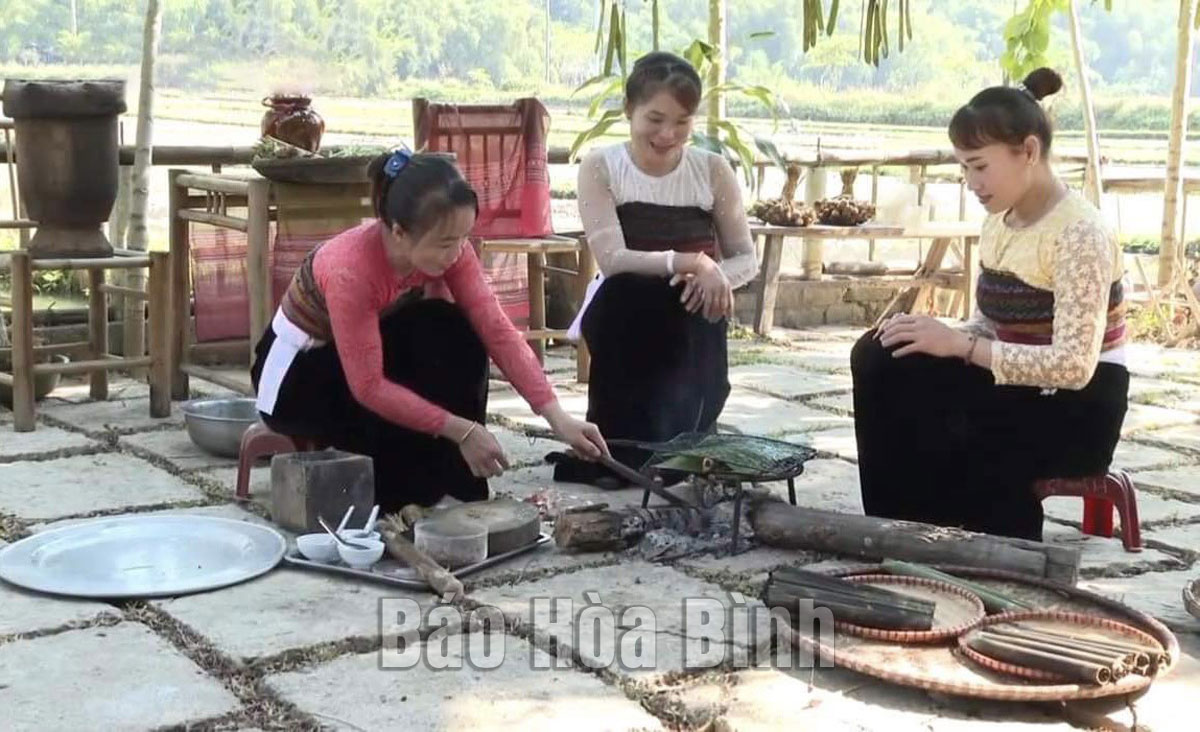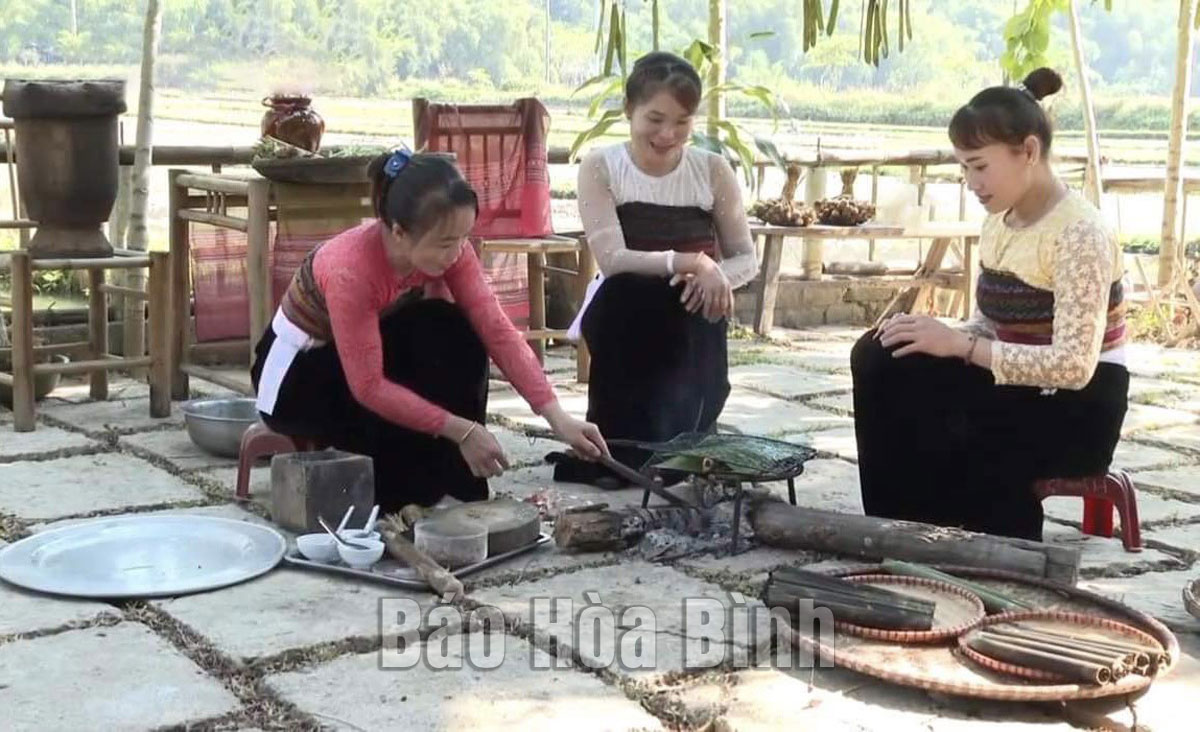
(HBO) - On the first days of the year, I went back to a beautiful land. There is a dish that enters the beautiful verses: "Mai Chau smells the sticky rice even if in women”. Even the sticky rice is as salty and seductive as Thai women themselves!
Thai ethnic women in Chieng Chau commune (Mai Chau) are prepare ingredients to make the traditional rice, Lam.
Going from the town to Da Trang Pass, people cannot help "falling in love” with the beautiful natural scenery which is like the paradise. Stop by a small stall with the fragrant sticky rice grown on the highland, it's easy to fall in love and it seems like you don't want to leave! When the hot smoke emits with a gentle fragrance, we can feel the quintessence of the cuisine of Thai ethnic people in the Northwest in this dish. Each grain of rice is stretched and shiny, naturally colored from leaves with eye-catching colors.
Being fascinated and curious how to create five-color sticky rice of Thai people, we went to Chieng Chau commune. Ms. Kha Thi Luan was born and raised on this land, so she knows all the secrets to cook the typical Thai dishes. We visited her house at the right time when she was dyeing rice for food, preparing for the family's year-end reunion meal, Ms. Luan said: Five-color sticky rice is an indispensable traditional dish in Thai rice trays, especially during the holidays and Tet of the Thai people in Mai Chau. To make the colorful sticky rice, it is necessary to choose a delicious variety of sticky rice grown on the terraced fields of the valley and it must be undergone the meticulous processing steps. After being soaked for many hours, the rice is dyed and then brought to the wooden pallet to be steamed twice. It is well-done for the first time, stir well, and the sticky rice is made softer and more flexible for the second time. The color of the sticky rice also has special meanings: The red represents the abundance, the yellow represents fullness, the purple is faithful, the white represents the pure love, and the blue is the color of the mountain in the Northwest forests.
Enjoying the upland sticky rice, you can have it with the grilled chicken raised on the hills, the grilled skewer pork or juicy stream fish. Even, there is no need to be so sophisticated, simply enjoying it with a bowl of sesame salt is enough to make the "ecstatic” taste.
Not only the sticky rice, the traditional dishes of Thai ethnic people show the combination and harmony with the spirit of the mountains and the simple humanity. For them, cuisine is an art that has become a deep and traditional cultural feature. According to Ms. Luan, to welcome the new year with lots of luck, Thai families bring areca nut and betel leaves inviting the village shaman to worship the ancestors, ward off the evil spirits and ask for good things from lunar December 24th to 26th. As the shaman is always respected most in the village in the Thai people's concept. The shaman can talk to the yin people, sending the best wishes of the existing peopel to the ancestors. For them, these days are an occasion to show the filial piety to the died people.
Normally, Thai dishes are divided into 5 different parts such as: Cham Cam (the dipping sauce is placed first); Cam Nam (the drinks are placed second); Cam Cap (the junk food is placed third); Cam Kin (the food is placed fourth); Cam Khau (the rice is put last). Appearing on the tray of rice on the last day of the year, there are also other special traditional dishes such as: grilled fish, dried meat, wild vegetables, bee pupa... All the dishes are made from the completely raw natural material, which is carefully marinated. In particular, the typical spice used by Thai people to marinate is "Mac Khen” (the wild pepper). A unique feature of Thai cuisine is that when cooking the dish they do not completely use the fat or the cooking oil, the cook carefully focuses on marinating with the spices in a suitable and harmonious way to create the dishes that are both delicious and attractive, attracting the enthusiasts of the traditional ethnic cuisine.
The People’s Committee of Lac Son district held a ceremony on April 28 to receive the provincial relic certificate for the ancient rock carving site at Suoi Co stream, located in My Thanh commune.
A special music show titled "The country is in the fullness of joy” has been held at Hoa Binh Square in Hoa Binh city in celebration of the 50th anniversary of the liberation of the South and national reunification (April 30, 1975–2025).
The People's Committee of Lo Son commune, Tan Lac district, has organised the local annual traditional stream fishing festival on April 19 - 20.
As a land deeply intertwined with human history and Vietnam’s millennia-long journey of nation-building and defence, Hoa Binh is often revered for its epic tales and legends.
Residents of Hoa Binh boast a rich cultural identity, reflected in their unique language, traditional attire, customs, and folk melodies – described as "sweet as honey, clear as a mountain stream.”
Lac Son district’s Vu ban town held the 2025 Truong Kha temple festival on April 12–13 (the 15th–16th days of the third lunar month). Since its revival in 2019, the festival has been organised every three years, preserving valuable intangible heritage while meeting the community’s cultural and spiritual needs.



